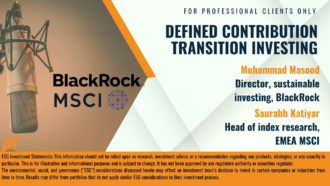Despite fears that the Covid-19 lockdowns will trigger a wave of corporate defaults, this could be an ideal time to invest in leveraged credit, says Dónal Kinsella, an institutional portfolio manager for corporate credit strategies at Eaton Vance.

PI: How has the leveraged credit market been impacted by the Covid-19 pandemic?
It has become slightly more leveraged. If you think of the leverage metric used by companies in the high- yield bond and floating-rate loan universe, it is a simple calculation of the amount of debt they have on their balance sheet divided by the earnings they generate.
If the debt has gone up, which it has in some parts of the market, or earnings have gone down, which has been the case in most parts of the market, then leverage metrics increase. So the risk inherent in our market has edged up in the midst of this pandemic.
As a result, the leveraged credit markets yield a lot more than they did before the pandemic took hold. With the sell-off that started in late February 2020, credit spreads and yields blew out, peaking in late March. They have rallied significantly since then, but they are still comfortably wider from a credit spread perspective and higher from a yield perspective than they were four months ago.
What returns should investors expect from this market?
That is the million-dollar question. If you look at index levels across high-yield bonds and floating-rate loans, we believe returns will be somewhere in the 4% to 6% per annum range on a five-year view, depending on how the default environment plays out. As active managers, we have faith in our ability to minimise losses and to avoid the worst performing companies in the market. So, perhaps the market can deliver a 4% to 6% return, but a solid active manager can perhaps deliver a 5% to 7% return.
I would say that the expectations of these longer-term return numbers are that they will not come in a straight line of, say, 5%, 6%, 7% per annum over the next three years. You are going to have bouts of volatility or excess positive returns in amongst that, but with a long enough time horizon those returns are extractable from the current market.
Markets are quite volatile at the moment, so why should institutional investors consider leveraged credit at a time like this?
Volatility has spiked across most risk assets so far this year, which often creates opportunities.
The volatility that we have seen is not specific to poorly run businesses. A lot of quality businesses have seen asset prices fall and yields rise on their debt.
So volatility creates opportunities where we can invest in good quality businesses with more attractive prospective returns than we had before the pandemic took off.
What areas of the leveraged credit market are you currently looking at?
Across our leveraged credit strategies, we have a broad global remit. We typically look anywhere that we can find positive returns, both on an absolute and risk-adjusted basis.
Sectors that have been in the eye of the storm from a Covid-19 perspective offer some great potential for long-term investors. Certain companies in the restaurant and leisure industries are businesses we think of as having long-term staying power but face short-term challenges. They have had to come to market and issue debt on attractive terms that could be seen as short-term bridge finance to get them through the worst of this situation.
Fallen angels are another opportunity. In the high-yield bond market, we have particularly seen a large slew of downgrades in the US and Europe. Typically, these companies will be working hard to improve their credit metrics and get back up to investment grade, which will be beneficial for their balance sheet in the long term.
We are picking and choosing the companies that have been downgraded that we feel will get back up to investment grade.
The third sector, which might be counter consensus, is energy. In April, oil prices fell into negative territory for the first time and energy bonds have seen their prices fall vociferously and are extremely volatile.
There will, in our view, be more destruction and defaults in that sector, but for companies that don’t default and have the ability to withstand oil prices being lower for longer, their returns will be quite exceptional when prices return to the top of the market.
How is Eaton Vance performing in this market relative to its peers?
Typically, we focus on how we are performing relative to our targets and by the investment process we communicate to clients and our prospects. That is we expect to outperform through a market cycle with more outperformance in the most challenging markets than in the strongest markets.
Across a suite of leveraged credit strategies, which includes high-yield corporate bonds, floating-rate loans and multi-asset credit, we have typically outperformed our benchmarks this year as well as over longer time periods.
How are you reducing risk in the leveraged credit market?
In general, we are not currently (as at 18 June) reducing risk in this market. In early March, as the pandemic was taking hold outside of Asia, we did reduce risk across some of our leveraged credit strategies by selling some of our assets and holding them in cash.
Typically, we would not take large cash positions in portfolios because our clients pay us to invest in bonds or loans, but the markets were so volatile that the opportunity cost of holding cash was low.
We were happy, in March, to increase cash balances across some of our strategies, but we have since reduced them because when credit spreads blew out broadly to a thousand basis points in the bond and loan markets, we saw that as an opportunity to invest in quality companies with attractive prospects.
How is Eaton Vance implementing ESG into its leveraged credit deals?
ESG is one of the factors we consider at the security selection level. We try and incorporate as broad an information set as we can with the aim of pricing risk appropriately and deciding where to invest.
We have access to proprietary research from a recently acquired subsidiary called Calvert Research and Management, which conducts in-depth ESG research at company and sector levels.
Our credit analysts have access to this information to help them build a fuller picture of the risks the companies that they cover are exposed to. At a security selection level, we try to make sure all relevant and financially material risks are taken account of and often the financially material risk will be ESG related.
How are you sourcing deals?
The same as ever. Our analysts are engaged with the secondary markets, so bonds and loans that have already been issued. They have great dialogue with the sell side and the banks to make sure that we are not missing an opportunity.
In recent months, we have seen a big uptick in companies issuing new debt, particularly in the US. We have invested in some of those deals.
Investing in a mix of primary and secondary markets is no different in this environment than it would be in any other.
What do you believe the post-Covid leveraged credit market will look like?
It is going to be bigger. We talked about fallen angels in the high-yield market. Since the onset of the crisis, we have seen upward of $200bn of fallen angels in the US and €50bn in Europe, so the opportunity set for leveraged credit investors is larger and the prospective returns are higher.
There is a bigger pool of assets to choose from while the yields and spreads on offer are better than they have been. Potentially, this is a fertile hunting ground for investors who are willing to accept a bit more volatility in their portfolio relative to any high-grade bond investments they hold.
These are the views of Eaton Vance’s leveraged credit team as at 18 June 2020.
Find out more about Eaton Vance’s leveraged credit capabilities
Important Additional Information and Disclosures
An imbalance in supply and demand in the income market may result in valuation uncertainties and greater volatility, less liquidity, widening credit spreads and a lack of price transparency in the market. Investments in income securities may be affected by changes in the creditworthiness of the issuer and are subject to the risk of non-payment of principal and interest. The value of income securities also may decline because of real or perceived concerns about the issuer’s ability to make principal and interest payments. As interest rates rise, the value of certain income investments is likely to decline. Investments involving higher risk do not necessarily mean higher return potential. Diversification cannot ensure a profit or eliminate the risk of loss. Debt securities are subject to risks that the issuer will not meet its payment obligations. Low rated or equivalent unrated debt securities of the type in which a strategy will invest generally offer a higher return than higher rated debt securities, but also are subject to greater risks that the issuer will default. Unrated bonds are generally regarded as being speculative.
Source of all data: LSTA, ICE BofAML indices and Eaton Vance, as at 18 June 2020, unless otherwise specified.
This material is presented for informational and illustrative purposes only. This material should not be construed as investment advice, a recommendation to purchase or sell specific securities, or to adopt any particular investment strategy; it has been prepared on the basis of publicly available information, internally developed data and other third-party sources believed to be reliable. However, no assurances are provided regarding the reliability of such information and Eaton Vance has not sought to independently verify information taken from public and third-party sources. Investment views, opinions, and/or analysis expressed constitute judgments as of the date of this material and are subject to change at any time without notice. Different views may be expressed based on different investment styles, objectives, opinions or philosophies. This material may contain statements that are not historical facts, referred to as forward-looking statements. Future results may differ significantly from those stated in forward-looking statements, depending on factors such as changes in securities or financial markets or general economic conditions.
This material is for the benefit of persons whom Eaton Vance reasonably believes it is permitted to communicate to and should not be forwarded to any other person without the consent of Eaton Vance. It is not addressed to any other person and may not be used by them for any purpose whatsoever. It expresses no views as to the suitability of the investments described herein to the individual circumstances of any recipient or otherwise. It is the responsibility of every person reading this document to satisfy himself as to the full observance of the laws of any relevant country, including obtaining any governmental or other consent which may be required or observing any other formality which needs to be observed in that country. Unless otherwise stated, returns and market values contained herein are presented in US Dollars.
In the United Kingdom, this material is issued by Eaton Vance Management (International) Limited (“EVMI”), 125 Old Broad Street, London, EC2N 1AR, UK, and is authorised and regulated by the Financial Conduct Authority. EVMI markets the services of the following strategic affiliates: Parametric Portfolio Associates® LLC (“PPA”), an investment advisor registered with the SEC. Hexavest Inc. (“Hexavest”) is an investment advisor based in Montreal, Canada and registered with the SEC in the United States, and has a strategic partnership with Eaton Vance, and Calvert Research and Management (“CRM”) is an investment advisor registered with the SEC. This material is issued by EVMI and is for Professional Clients/Accredited Investors only.
In Ireland, Eaton Vance Global Advisors Ltd (“EVGA”) is registered in the Republic of Ireland with Registered Office at 70 Sir John Rogerson’s Quay, Dublin 2, Ireland. EVGA is regulated by the Central Bank of Ireland with Company Number: 224763.
In Germany, Eaton Vance Global Advisors Limited, Deutschland (“EVGAD”) is a branch office of Eaton Vance Global Advisors Limited (“EVGA”). EVGAD has been approved as a branch of EVGA by BaFin.
Eaton Vance Distributors, Inc. (“EVD”), Two International Place, Boston, MA 02110, (800) 225-6265. Member of FINRA/ SIPC.
Eaton Vance Investment Counsel. Two International Place, Boston, MA 02110. Eaton Vance Investment Counsel is a wholly-owned subsidiary of EVC and is registered with the SEC as an investment adviser under the Advisers Act.
Investing entails risks and there can be no assurance that Eaton Vance, or its affiliates, will achieve profits or avoid incurring losses. It is not possible to invest directly in an index. Past performance is not a reliable indicator of future results.




